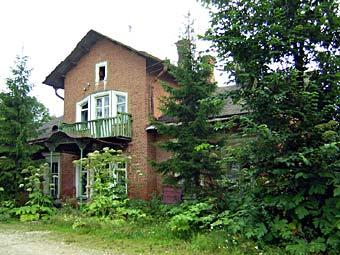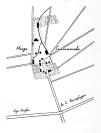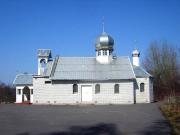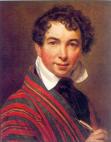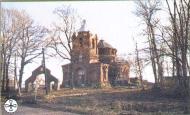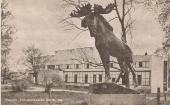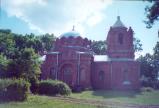Articles
/
Kotli, a country estate
Kotli, a country estate
Subject /
Architecture/Country estates
Kotly, a country estate (the village of Kotli, the Kingisepp district). Since 1730 the grange of Kotelskaya belonged to the Barons Albrekhts. All buildings including a Lutheran and Orthodox churches were wooden. In the early 19th century under I.L. Albrekht the estate was enlarged and replanned, pareks were laid out and two-storied stone mansion with the big sixstyle portico was built in the 1820s presumedly according to the project of the architect A.I. Melnikov. The Albrekhts' family burial-vault made of limestone plates was located in the park since the 18th century. The service -yard was surrounded with limestone wall, a gatehouse and garden pavilion were built near the gate. The estate planning and stylistic unity of its buildings made the estate one of the most remarkable in the gubernia. By invitations of the owners in 1827 the painter O.A. Kiprensky visited the estate and worked there. In the late 19th - the early 20th century estate was owned by A.I. Mamontov, N.A. Sapozhnikova and her daughter O.A. Meisner. In 1882-1888 the Church of St. Nicolas the Wonderworker was built. On our days the mansion and service constructions have been intacted in part.
Authors
Chekanova, Olga Aleksandrovna
Persons
Albrecht, Ivan Lvovich
Albrechts, the
Kiprensky, Orest Adamovich
Mamontov, Arkady Ivanovich
Melnikov, Abraham Ivanovich
Meysner (nee Sapozhnikova), Olga Aleksandrovna
Sapozhnikova (nee Kozachenko), Nina Aleksandrovna
Geography
Leningrad Oblast, the/Kingisepp District/Kotli Village
Bibliography
Громов В.И., Файнштейн Л.А. Памятные места Ленинградской области. Л., 1959., 150-154
Мурашова Н.В., Мыслина Л.П. Дворянские усадьбы Санкт-Петербургской губернии. Кингисеппский район. СПб., 2003., 103-122
Мурашова Н.В. Сто дворянских усадеб Санкт-Петербургской губернии: Исторический справочник. СПб., 2005., 150-154
Subject Index
The Church of Sainted Hierach Nicholas the Wonderworker (Kotly Village, Kingisepp District)
Mentioned in articles:
|
hidden
|
Country estates
Country estates. In the early 20th century on the territory of the modern Leningrad Oblast there were 2000 country estates. Mainly they appeared at one time with St. Petersburg. There were not many "Family nests" that belonged to one family and... more
|
|
|
|
hidden
|
Gomontovo, a country estate
Gomontovo, a country estate (the village of Gomontovo, the Volosovo district). The village belonged to Varvara Lvovna Fermor, the wife of Count V.V. Fermor. Later it passed to her nephew K.I. Albrekht, the owner of the estate of Kotli. In 1838 the... more
|
|
|
|
hidden
|
Kingisepp District
KINGISEPP DISTRICT, a part of Leningrad Oblast. Population: 74,300, of which, 52,100 live in the adm. center Kingisepp Town. Area: 2842.1 sq. km. It has 191 rural settlements. It was established in 1927.It borders with Lomonosov, Volosovo, and... more
|
|
|
|
hidden
|
Kiprensky, Orest Adamovich (1782-1836), an artist
KIPRENSKY, Orest Adamovich (1782, country house in Nezhinskaya Village; modern Nezhnovo Village, Kingisepp District – 1836), artist, a founder of romanticism in Russian painting. He was an illegitimate son of a serf woman and a landlord A.S.... more
|
|
|
|
hidden
|
Kotli, village
KOTLI (Finnish Kattila), a village in Kingisepp District. Population: 2013, mostly Russians and Vod. Located at the north-western end of the Izhora Hills, on a glint terrace. First mentioned in the 1499/1500 Rent Census Book of Vodskaya Pyatina as... more
|
|
|
|
hidden
|
Sculptures and monuments
Sculptures and monuments. The first sculpture samples appeared in St. Petersburg outskirts at the time of peter I ruling. During the 18th century decorative sculpture was the inherent part of park ensembles of Peterhof, Oraniyenbaum, Tsarskoye... more
|
|
|
|
hidden
|
The Church of Sainted Hierach Nicholas the Wonderworker (Kotly Village, Kingisepp District)
The Church of St Hierach Nicholas the Wonderworker (Kotly Village, the Kingisepp District). In the territory of the Toldozhsky Nikolsky Pogost of Chud's land the original wooden church was built not later then 1499. The church was rebuilt more... more
|
|
|
|






